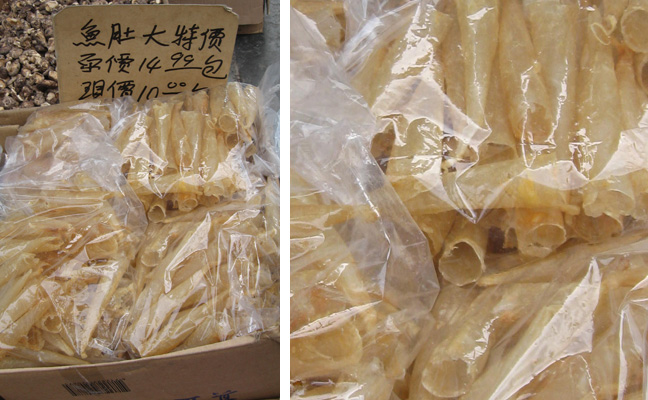Chinatown Mystery #4
By Dyske April 21st, 2009

These look like the heads of small squids. Is that right? I can read the first character (fish), but I can’t make sense of the rest. The shape is perfect for serving appetizers. In any case, what are they? How do you eat them?


EChan says:
April 22nd, 2009 at 1:11 pmFish Stomach.
Frank Luo says:
April 22nd, 2009 at 1:50 pmEven though it is known in Chinese as 鱼肚 Yudu, literally fish abdomen but also possibly taken as fish stomach, this is actually the swim bladder.
Fish and other marine creatures (sharks, for example, which are not technically fish) have a bladders in their torsos to help them control buoyancy. This bladder, taken from the fish and dried, is highly prized by the Chinese both for its nutritional value and the taste, being classified as one of the 八珍 Bazhen, literrally the “eight rare [delicacies].”
I have never cooked this item and so do not have a recipe of my own to offer, but according to online sources, you would rehydrate these either by soaking in water or poached in oil (not deep fried — there is a difference: poached in oil is when you see a bubble emerging occasionally, deep fry is when you hear a loud sizze and the oil is bubbling vigorously when the food is immersed in the oil), then stewed with other meats, most likely chicken, along with ginger, rice wine, and various herbs and spices.
Dyske says:
April 22nd, 2009 at 10:11 pmThank you, Frank. Interesting. So, they are not used for stuffing things? If these were to be served at a Chinese restaurant, what would the menu say? “fish bladder”?
Frank Luo says:
April 23rd, 2009 at 12:26 pmWell, “bladder” is what urine is stored in. There is a separate Chinese character for the swim bladder, 鳔.
And, no, they are not used for stuffing things that I know… But I am not as advanced a cook as I’d like to be and it may be that some chefs do. All I can say is that for stuffing things, you would need to maintain the integrity of the sac, which would make proper drying and transportation very much more difficult.
But as I said some enterprising chef might have this done. I have just never seen it.
As for how it might be billed in a Chinese restaurant — since it is known as 鱼肚 or fish abdomen in Chinese, you will most commonly see it translated as fish belly — “swim bladder” doesn’t sound great on a menu, and in all likelihood, whoever does the translation for a restaurant menu may either 1) not actually know what this is, and would go with the literal textual meaning, or 2) would not know the English term “swim bladder.” I am forever picking out such errors when I edit translations.
You can usually find 沙锅鱼肚 Shaguo Yudu; typically rendered in English as “Fish belly (stew) in clay pot” in a decent-sized Chinatown restaurant, especially one that bills itself as a seafood place.
Lee-Sean says:
April 23rd, 2009 at 1:42 pmWow! Frank Luo is the master of all Chinatown mysteries.
Lee-Sean says:
April 23rd, 2009 at 1:43 pmI’ve seen “yudu” a lot in soups at banquets in Taiwan.
pmmonkey says:
April 23rd, 2009 at 2:43 pmIn menus in many places, it’s more commonly called fish maw.
Frank Luo says:
April 23rd, 2009 at 6:45 pmHmm. Curious about the stuffing of fish bellies, I went googling for it and found this:
http://www.flickr.com/photos/avlxyz/3224357315/
…but it translates Yudu as “fish maw.” Still, I googled it a bit more in Chinese and found a few other recipes, including one where fish liver is stuffed into the fish swim bladder.
My bad… Will do this googling BEFORE replying next time…